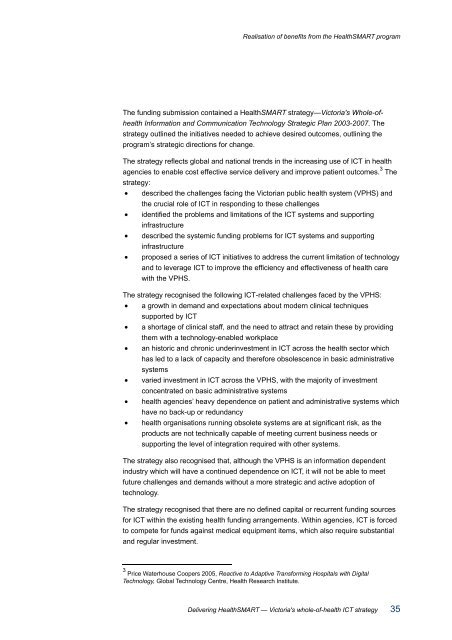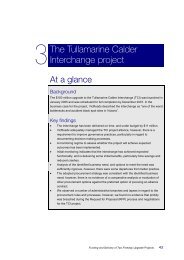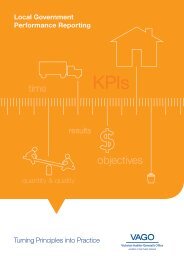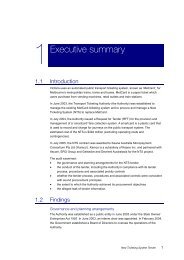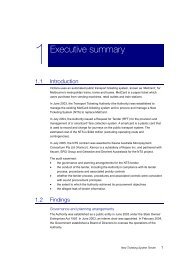Delivering HealthSmart Report - VAGO
Delivering HealthSmart Report - VAGO
Delivering HealthSmart Report - VAGO
Create successful ePaper yourself
Turn your PDF publications into a flip-book with our unique Google optimized e-Paper software.
Realisation of benefits from the HealthSMART program<br />
The funding submission contained a HealthSMART strategy—Victoria's Whole-ofhealth<br />
Information and Communication Technology Strategic Plan 2003-2007. The<br />
strategy outlined the initiatives needed to achieve desired outcomes, outlining the<br />
program’s strategic directions for change.<br />
The strategy reflects global and national trends in the increasing use of ICT in health<br />
agencies to enable cost effective service delivery and improve patient outcomes. 3 The<br />
strategy:<br />
• described the challenges facing the Victorian public health system (VPHS) and<br />
the crucial role of ICT in responding to these challenges<br />
• identified the problems and limitations of the ICT systems and supporting<br />
infrastructure<br />
• described the systemic funding problems for ICT systems and supporting<br />
infrastructure<br />
• proposed a series of ICT initiatives to address the current limitation of technology<br />
and to leverage ICT to improve the efficiency and effectiveness of health care<br />
with the VPHS.<br />
The strategy recognised the following ICT-related challenges faced by the VPHS:<br />
• a growth in demand and expectations about modern clinical techniques<br />
supported by ICT<br />
• a shortage of clinical staff, and the need to attract and retain these by providing<br />
them with a technology-enabled workplace<br />
• an historic and chronic underinvestment in ICT across the health sector which<br />
has led to a lack of capacity and therefore obsolescence in basic administrative<br />
systems<br />
• varied investment in ICT across the VPHS, with the majority of investment<br />
concentrated on basic administrative systems<br />
• health agencies’ heavy dependence on patient and administrative systems which<br />
have no back-up or redundancy<br />
• health organisations running obsolete systems are at significant risk, as the<br />
products are not technically capable of meeting current business needs or<br />
supporting the level of integration required with other systems.<br />
The strategy also recognised that, although the VPHS is an information dependent<br />
industry which will have a continued dependence on ICT, it will not be able to meet<br />
future challenges and demands without a more strategic and active adoption of<br />
technology.<br />
The strategy recognised that there are no defined capital or recurrent funding sources<br />
for ICT within the existing health funding arrangements. Within agencies, ICT is forced<br />
to compete for funds against medical equipment items, which also require substantial<br />
and regular investment.<br />
3 Price Waterhouse Coopers 2005, Reactive to Adaptive Transforming Hospitals with Digital<br />
Technology, Global Technology Centre, Health Research Institute.<br />
<strong>Delivering</strong> HealthSMART — Victoria's whole-of-health ICT strategy 35


